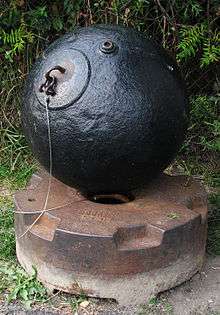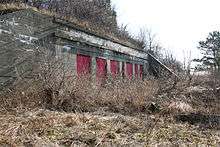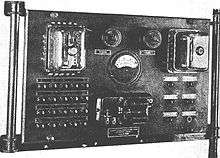Submarine mines in United States harbor defense


The modern era of defending American harbors with submarine mines (originally referred to as "torpedos") began in the post-Civil War period.
In 1866, the United States Army Corps of Engineers established the Engineer School of Application at Willets Point, NY. The first commander of this School, Maj. Henry Larcom Abbot, was almost single-handedly responsible for designing and supervising the program of research and development that defined the strategy and tactics for the mine defense of American harbors. Abbot experimented with underwater explosives, fuzes, cabling, and electrical equipment for over a decade before publishing the first manuals on the use of mines in coast defense in 1876–77.
Then, in 1886, the Endicott Board made its report on harbor defense, giving rise to a vast expansion in the building of modern forts, the installation of new guns, and the preparation of mine defenses at newly-created Coast Defense Commands.
From about 1900 until 1946 the mine defense program grew, until upwards of 10,000 controlled mines were maintained by the U.S. Army's Coast Artillery Corps.[1] In July 1918, the U.S. Army Mine Planter Service (AMPS) was established to maintain U.S. mine defenses.
Controlled mines were anchored to the bottom of a harbor, either sitting on the bottom itself (ground mines) or floating (buoyant mines) at depths which could vary widely, from about 20 to 250 feet (6–75 m). These mines were fired electrically through a vast network of underwater electrical cables at each protected harbor. Mines could be set to explode on contact or be triggered by the operator, based on reports of the position of enemy ships. The networks of cables terminated on shore in massive concrete bunkers called mine casemates (see photo, below-right), that were usually buried beneath protective coverings of earth.
The mine casemate housed electrical generators, batteries, control panels, and troops that were used to test the readiness of the mines and to fire them when needed.[2] The map of Boston Harbor's mine fields (below, right) shows the harbor mine defenses consisting of 30 groups of mines, with 19 mines per group. Each mine was normally loaded with 200 lb (91 kg) of TNT. So in Boston's case, a total of 57 tons of explosives guarded the harbor.[3]
Each protected harbor also maintained a small fleet of mine planters and tenders that were used to plant the mines in precise patterns, haul them back up periodically to check their condition (or to remove them back to the shore during peacetime), and then plant them again.[4] Each of these harbors also had on-shore facilities to store the mines and the TNT used to fill them, to load and transport the mines (which often weighed over 750 lb (340 kg). each when loaded), and to test and repair the electrical cables. Fire control structures were also built that were used first to observe the mine-planting process and fix location of each mine and second to track attacking ships, reporting when specific mines should be detonated (so-called "observed fire"). The preferred method of using the mines was to set them to detonate a set period of time after they had been touched or tipped, avoiding the need for observers to spot each target ship.
Control


Each mine casemate (depending on local harbor conditions) controlled about 150 to 300 mines, arranged in groups of 19.[5] The mines in one group were generally laid about 100 ft (30 m) apart, in lines running across the channel being protected (with 50 ft (15 m) or less on either end of the line). This meant that one group of mines could protect a total distance of about 1,900 ft (580 m)[6] If more groups of mines were needed, multiple mine casemates were generally built and equipped. For example, Boston had three mine casemates, at Fort Dawes on Deer Island (northern channels) and Fort Strong on Long Island (southern channels). Later in WW2, Fort Strong's mine casemate was closed and control of the southern mines passed to Fort Warren on Georges Island.


The shore cable from the underwater distribution box of each mine group ran back to a cable hut on the shore near the mine casemate, and from there to the casemate itself, where it was connected to a mine control panel (see photo at left, below). These panels were located in the casemate's operating room, pictured at left-center in the plan shown at right. (This is the plan of the Ft. Strong mine casemate, the one shown in the photo directly above it.)
In addition to these firing controls, the mine casemate contained one or more electric generators and a large bank of electrical storage batteries. The generators produced direct current, which was used to signal the readiness of the mines. An interrupter was used to convert a portion of this current to AC which was used to fire the mines: the distinct current supply was a safety feature. The casemate also had a number of telephone lines, keeping it in touch with remotely located mine observation and fire-control positions, with the mine commander, and with the gun batteries and searchlights that covered the mine fields. The casemate also contained switching and diagnostic equipment used to test cable integrity and the functionality of the individual and group mine detonation switches.
Since the busiest mine casemate in Boston Harbor (for example) controlled 15 mine groups (285 mines), it would have mounted 15 of these mine control panels, plus many more related rack-mount devices for controlling the casemate's generators, inverters, and battery systems.
The mines could be fired in three ways, listed here in order of tactical preference:
- Delayed Contact Fire: the mine was switched into contact firing status a certain number of seconds after it signaled it had been touched or tipped.
- Contact Fire: the mine was set to explode as soon as it was touched or tipped.
- Observation Fire: target was tracked, its position plotted by the mine fire control tower/s, and an appropriate mine in its path was fired at a time when the observers indicated the target was within the kill zone for that mine.
Delayed contact fire was preferred because it was thought that the mine would first be dragged underneath the target and then fired after a few seconds' delay, once it had had the chance to contact a more lightly protected portion of the target's bottom. This type of fire required the casemate troops to hear the bell and see the accompanying signal light that indicated when a given mine was tipped, wait several seconds, and then throw the firing switch for that mine's group into "fire" position to detonate the mine.
In contact fire mode, each mine in the group was set to explode when contacted or tipped by a ship; in observed fire mode, mines were fired in a fashion similar to that used under the fire control system for the coast artillery batteries defending the harbor: distant observers took bearings on targets though spotting telescopes, and these bearings were used to plot the target's position.
It was suggested that contact fire or delayed contact fire was most useful in situations when more than one enemy ship was approaching the mine field, or was approaching quite rapidly, which made observed fire more difficult, or under conditions of poor visibility. On the other hand, these types of fire made it much more dangerous for any friendly shipping that might be near the mine field.
Maintenance

Extensive on-shore facilities, as well as a small fleet of mine-planting boats, supported each mine casemate. For Fort Strong in Boston Harbor, these facilities are illustrated in the map shown at right.
The mine wharf was the place that mineplanters tied up to load or unload their cargo of mines and connecting cable. This wharf was equipped with a heavy lifting crane. From the wharf, returning mines were carried by the mine tramway (running on the track shown on the map) to the torpedo storehouse ("torpedo" was an alternative term for "mine"). This storehouse was the largest building in the mine complex, and was used to store the mines, on large racks, when they had been pulled from the water for testing, repair, or storage (for example, when peace had broken out). Loaded mines were also stored in the underground magazines of the Coast Artillery batteries (which were otherwise abandoned after about 1925) at the top of the bluff on the northern end of the fort. These magazines were reached by following the tramway off the map towards the lower left, where it ran up a gradual slope past the "reservoir" (water tower).
Another branch of the tramway lead to the loading room, where the TNT charges for the mines were loaded into or unloaded from the mines. A very small TNT storehouse was immediately adjacent to the loading room. Only one box of TNT – 100 lb (45 kg), or half of the load for an average mine – was supposed to be taken from this storehouse at a time for loading.
Another branch of the tramway track lead to the cable tanks, large concrete tanks filled with seawater pumped from the harbor and used for insulation and conductivity testing on the many miles of electrical cable that were used for mine operations. The torpedo storehouse had its own smaller tanks that were used for submergence testing of the mine casings and their fuzes, which were inserted into the casings through watertight plugs.
The mine casemate (pictured in the photo above and in the plan drawing) is also shown on the map. Its coordinates (42°19′46″N 70°57′30″W / 42.329388°N 70.958288°W) indicate the approximate center of the structure. All traces of the other mine facilities were destroyed by the City of Boston in the 1990s during the redevelopment of the northern end of the fort and its parade ground for use as a summer camp for city children.
See also
- Mine Planter Service (U.S. Army)
- Mine planter
- Minelayer
- Harbor Defense Museum
- List of ships of the United States Army
- Seacoast defense in the United States
- United States Army Coast Artillery Corps
References
- ↑ For an excellent summary, see Mark Berhow, "Controlled Mines in US Army Seacoast Defenses," in Mark Berhow, Ed, "American Seacoast Defenses," CDSG Press, McLean, VA, 2004, p.326, CDSG.org.
- ↑ A manual of the period that explains mine defense (including the details of mine-planting and the electrical systems needed for the mines) is Training Manual TM 2160-20, "Submarine Mining," U.S. War Department, Washington, D.C., October 15, 1930.
- ↑ As was the case with other parts of the U.S. coast defense system (e.g., its thousands of guns), there is no evidence that a mine was ever fired in anger against an attacking enemy. There is a report that a submarine attempted to penetrate the mine fields of Boston Harbor in June, 1942 but reportedly withdrew before the mines could be fired or reset to detonate on contact. See Gerald Butler, "The Military History of Boston's Harbor Islands, Arcadia Publishing, 2000, p. 71.
- ↑ See supra, Note 2, Sections XXIV–XXVI. This manual contains a detailed description of the process of mine planting and describes in great detail how the ships and smaller craft were to be deployed to accomplish this task.
- ↑ Each distribution box (see drawing at left, above) had twenty connections, allowing for 19 mines and one link to the shore.
- ↑ About 3 miles (4.8 km) of cable were required to connect one group of 19 mines to its distribution box, with the connecting cables radiating out from the box in a hub-and-spoke fashion. Actually, the distribution box was usually located well behind the line of mines, so the pattern looked more like a 19-armed candelabrum with the box at its base.
- Berhow, Mark A., Ed. (2004). American Seacoast Defenses, A Reference Guide, Second Edition. CDSG Press. ISBN 0-9748167-0-1.
- Lewis, Emanuel Raymond (1979). Seacoast Fortifications of the United States. Annapolis: Leeward Publications. ISBN 978-0-929521-11-4.